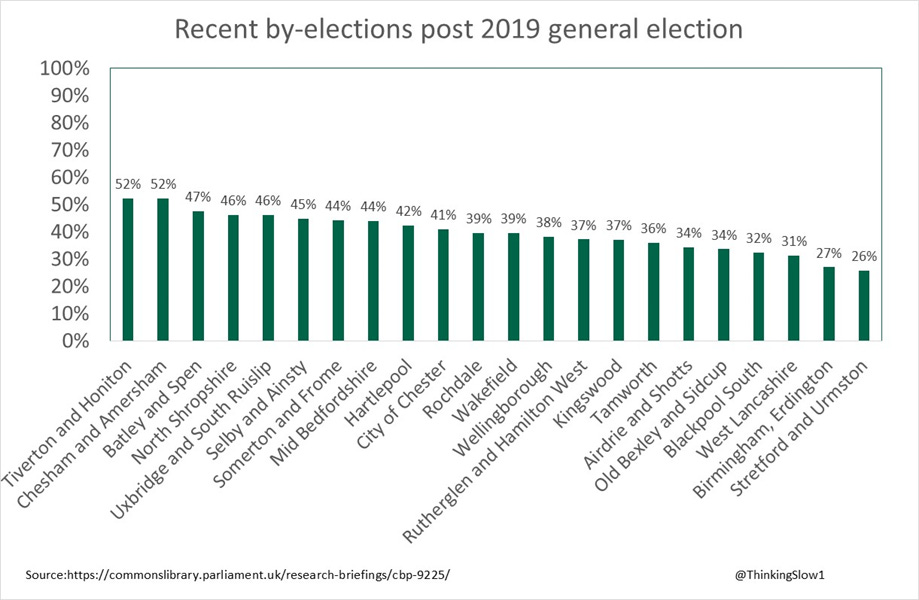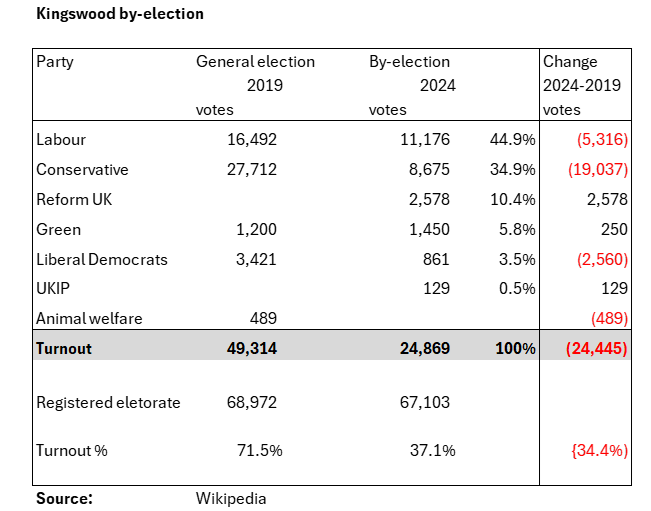Introduction
I have written about the big picture at Reform UK and why I believe this “anti-establishment” party is actually an establishment distraction. Here, I wanted to dig into some numbers and look at how big a threat a real anti-establishment party could be to the cosy Uniparty arrangements. An important indicator of the extent to which voters are fed up with both Labour and Conservative is recent voter turnout in by-elections, low voter turnout means that large numbers of people are uninspired by both options.
In a recent Commons Library report the turnout of the 2019 to 2023 by-election season was shown as 39.4%, which jointly with the 2001-05 season was the lowest level since 19451. The turnout at general elections is around about 25% higher than at by-elections, but the low 2001-05 by-election season coincided with a very low general election turnout in 2001 (59.4%). This level of frustration creates a tremendous opportunity for genuine anti-establishment opposition, if they are embraced by disaffected voters. By way of illustration, if disaffected voters who voted at the 2019 election turned up at the recent 22 by-elections and got behind a new third party (or good independent candidate), then that third party could have won 17 of the last 22 by-elections. That number is based on the aggressive assumption that everyone who voted at the 2019 election got behind a single third party candidate, which is very unlikely, but this gives an order of magnitude estimate of what may be at stake.
I was reasonably early to raise the idea that the apparently competing right and left parties were actually pushing an almost identical agenda an idea which is now widely accepted.
2019 to 2023 by-elections
If you can accept the idea that the oligarchy has effectively captured the two main parties and made them into vehicles to introduce some kind of Frankenstein global-corporate-communism, then surely it is not too much of a leap of faith to imagine that the oligarchy would also take steps to prevent this cosy set-up being disrupted by genuine challenger parties. Hence the need for controlled challenger parties.
Within the 2019-2023 period which averaged 39.6% turnout overall (excluding Southend West), there were 22 by-elections, 20 of them were decided on a turnout of less than 50% (see chart). 50% is not a magic number in the electoral arena, but is a common concept in corporate law where a quorum (minimum attendance) of 50% is often required for shareholder and board meetings to be duly constituted. Failure to achieve a quorum generally results in the cancelation of a meeting, with it being re-run with a lower quorum requirement.
As far as I know, there are no legal implications from low turnout figures, it would still be embarrassing for the Establishment given that they intended to ram through a radical plan to impose significant top-down social engineering, including via Net Zero. If you assume that the winning share of a U.K. election is around 43.7% (2019 ), then you could see a scenario where around 75% of the voting age population did not support a Starmer government (assuming a 60% turnout). 60% would be a repeat of 2001 and actually a lower level could have been possible, before the arrival of Reform UK.
The threat from a new party
As well as having a large number of people not playing the election game, there is an even bigger threat which is that the voters fed up with the Uniparty coalesce around a new third party. As discussed in the introduction, using an illustration where all the disaffected voters who turned out in the 2019 general election voted for a new third party, that party would have won 17 from the 22 by-elections. The example of Kingswood illustrates how this might work in practice. Looking at the change in votes between the 2019 general election and the 15th Feb 2024 by-election triggered by the resignation of Chris Skidmore (a grade A charlatan, in my opinion). As you can see Labour won the seat despite the fact that more than five thousand fewer people voted for them than at the general election2.
It would, in theory, be relatively straightforward to beat the Labour candidate by mobilising 45% of the people who did not vote (11,177/24,445). Also it is worth noting that if the Reform votes were taken from the Conservative vote, then they did indeed prevent a Conservative win, however ill-deserved (the Conservative total vote would have been 11,253, marginally above Labour).
This of course represented a huge opportunity for the real opposition parties like ADF and Heritage, but the appearance of a high profile and well-funded Reform UK charade has taken much of the wind out of their sails. I suspect this is not an accident.
Conclusion
I provided extensive evidence in the previous article to show why I believe that Reform UK is not an organic anti-Establishment party3. You can see in this note how its appearance could achieve two establishment aims of i) increasing voter turnout which was potentially embarrassingly low, without affecting the outcome and ii) preventing consolidation around genuine anti-establishment parties.
I continue to believe that not voting or spoiled ballots are more, or less pointless, there are no quorum requirements in voting and a low turnout would be embarrassing, but would be unlikely to affect the Great Reset idealogues. The only sensible way out of this situation is to reject parties that are heavily dependent on oligarchs, multinational corporates or media barons (as Reform UK is) and back real grass roots parties and strong independent candidates. At this stage, that is probably a pipe dream as many people will likely chose between parties that they are aware of and which are well funded. Awareness of a party depends largely upon its media presence, which in turn depends upon funding and a sympathetic media. People would need to reject the corporatized political party offerings in large numbers and engage in their own due diligence on independent parties and candidates. This prospect is a long way off. There is of course an added problem that there are dozens of smaller parties receiving fractions of a percentage of the national vote. Also an important issue that I set out in an earlier note is that little value seems to be placed on integrity and many electors will favour a candidate with chutzpah even if they are completely unreliable (Boris Johnson anyone).
People may of course scoff that this is a pipe dream, but in my view it better to pursue a pipe dream than the other options of either of opting out and having a Great Reset imposed upon you anyway, or agreeing to remain locked in an endless choice between the least bad Establishment offerings.
Let me have your thoughts below and please don’t forget to circulate our material and support our work, we have already had to suspend various parts of our activities due to lack of funding, soon we may have to close as only a tiny number of people reading our labour intensive reports have a paid subscription, or patreon contribution (https://buymeacoffee.com/thinkingslow and Patreon.com/ThinkingSlow).
Many thanks
Alex
Alex Kriel is by training a physicist and was one of the first people to highlight the flawed nature of the Imperial COVID model4, he is a founder of the Thinking Coalition which comprises a group of citizens who are concerned about Government overreach (www.thinkingcoalition.com)
https://commonslibrary.parliament.uk/research-briefings/cbp-7529/
The year of 1974 is excluded because there was only 1 by-election in that year, which generated an unrepresentative number.
https://en.wikipedia.org/wiki/2024_Kingswood_by-election
Reform UK - another Trojan horse
People are getting the feeling that something feels scripted about the collapse of the Fake-Conservative party and the simultaneous rise of Reform UK. They are right to feel that and in my view there is little doubt that we are witnessing a scripted handover.








